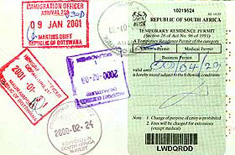Visas, permits, residence
Rainbow immigration
-
Read more:
- South Africa tightens immigration rules
- South Africa opens new visa facilitation centres
- South Africa to enforce new regulations on travelling with kids
Immigration trends
International population movements, influenced as they are by a variety of socioeconomic, political, environmental and other factors, are complex to measure. There are, in fact, no official figures available on the total number of foreign residents in South Africa. However, figures from South Africa’s 2011 Census suggest that 3.3% — or about 1.7-million — of the country’s 51.7-million population are "non-South African" citizens. According to AfricaCheck, data collated by the World Bank and the United Nations also suggests a migrant population of about 1.86- million people. A report by Statistics South Africa on immigration statistics drawn from Home Affairs data shows that 1 283 permanent residence permits were issued in 2012. About half of the issued permits were acquired using the relatives’ category status, while only 50 or 4% used refugee status. Nationals from Zimbabwe (20%), the UK (11%), Congo (7%), China (7%), India (6%), Germany (5%), Nigeria (5%) and DRC (3%) made up almost 64% the recipients of permanent residence permits.Emigration trends
While reasons for emigration are varied, and unique to individuals, many choose to settle in more developed countries in Europe or North America, where the earning potential for skilled labour tends to be higher. The exodus of skills from the country have affected the IT industry, the scientific and medical professions, including nursing, as well as teaching. The downfall of the so-called "brain drain" is a shortage of skilled labour at home. Yet the skills shortfalls are opportunities for some – providing business and work opportunities for a fresh wave of immigrants, and focusing skills development initiatives, as well as guiding tertiary education decisions at home. Statistics South Africa no longer collects information on emigration. However, data from the Organisation of Economic Co-operation and Development (OECD) quoted by Politicsweb in 2012 show 588 388 South African emigrants aged 15 or over were living in OECD countries in 2010. The countries with the highest numbers of individuals born in South Africa are, in descending order: the United Kingdom, Australia, the United States, New Zealand, and Canada. A study released in 2014 by workforce management company Adcorp showed that nearly 359 000 "high skilled South Africans" have returned home from overseas assignments since the global financial crisis of 2008-9. "This is a sizeable number, representing 18% of the total pool of managers and professionals in South Africa and 12% of the total pool of graduates," Adcorp said in a statement.- Read more: Skills 'flowing back into South Africa'
Exceptional people
Ebrahim Ebrahim, the Deputy Minister of International Relations and Co-operation, told the South African diaspora in Perth Australia in November 2013 that South Africans - no matter where they resided - could still be a part of South Africa's growth and development. Brand South Africa's Global South Africans programme believes South African expats "can be priceless resource for our country – your country – as we strive compete and win in the global economy", he said. "Brand South Africa's US country manager has done some research on America's South African born population. It currently numbers around 85 000. Its household income is roughly double the US national median, likewise the value of the houses it lives in. "South Africans in the US are also vastly better educated than the general population and much more likely to have advanced degrees. Overall, Brand South Africa estimates, the net worth of South Africans living in America is around $13-billion." Ebrahim said one of the most valuable contributions any Global South could make was to speak well and proudly of the country and to be living proof of the caliber of people South Africa produces.- Read the deputy minister's speech in full
- Visit the Global South Africans website
Would you like to use this article in your publication or on your website? See: Using SAinfo material



